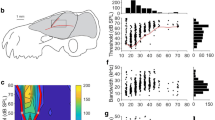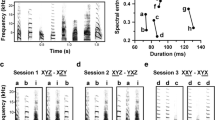Summary
The coding of sound frequency and location in the avian auditory midbrain nucleus (nMLD) was examined in three diurnal raptors: the brown falcon (Falco berigora), the swamp harrier (Circus aeruginosus) and the brown goshawk (Accipiter fasciatus). Previously this nucleus has been studied with free field stimuli in only one other species, the barn owl (Tyto alba).
We found some parallels between the organisation of nMLD in the diurnal raptors and that reported in the barn owl in that the central region of nMLD was tonotopically organised and contained cells that did not encode location, and the lateral region (nMLDl) contained cells which were sensitive to stimulus position. However, unlike the barn owl, which has units with circumscribed receptive fields, cells sensitive to stimulus location had large receptive fields which were restricted in azimuth but not in elevation (hemifield units). Such cells could not provide an acoustic space map in which both azimuthal and elevational dimensions were represented, but there was a tendency for units with contralateral borders to be found superficially, and those with ipsilateral borders to be found deep, in nMLDl. Hemifield units displayed receptive field properties consistent with the directional properties of the tympana in the presence of sound transmission through the interaural canal, if there is a central mechanism which is sensitive to interaural intensity differences.
Similar content being viewed by others
Abbreviations
- nMLD :
-
nucleus mesencephalicus lateralis pars dorsalis
- SPL :
-
sound pressure level re 20 μPa
- nMLDl :
-
lateral region of nMLD
- ICC :
-
central nucleus of the inferior colliculus
- ICX :
-
external nucleus of the inferior colliculus
- IID :
-
interaural intensity difference
- EI :
-
excitatory inhibitory
References
Aitkin LM, Kenyon CE, Philpott P (1981) The representation of the auditory and somatosensory systems in the external nucleus of the cat inferior colliculus. J Comp Neurol 196:25–40
Aitkin LM, Horseman BG, Bush BMH (1982) Some aspects of the auditory pathway and audition in the European mole,Talpa europaea. Brain Behav Evol 21:49–59
Aitkin LM, Gates GR, Phillips SC (1984) Responses of neurons in the inferior colliculus to variations in sound source azimuth. J Neurophysiol 52:1–17
Aitkin LM, Pettigrew JD, Calford MB, Phillips SC, Wise LZ (1985) Representation of stimulus azimuth by low-frequency neurons in inferior colliculus of the cat. J Neurophysiol 53:43–59
Andersen RA, Snyder RL, Merzenich MM (1980) The topographic organization of corticocollicular projections from physiologically defined loci in AI, AII and anterior auditory fields of the cat. J Comp Neurol 191:479–494
Calford MB, Pettigrew JD (1984) Frequency dependence of directional amplification at the cat's pinna. Hearing Res 14:13–19
Coles RB, Aitkin LM (1979) The response properties of auditory neurons in the midbrain of the domestic fowl (Gallus gallus) to monaural and binaural stimuli. J Comp Physiol 134:241–251
Coles RB, Guppy A (1983) Peripheral mechanisms of directional hearing in the barn owl (Tyto alba). In: Webster WR, Aitkin LM (eds) Mechanisms of hearing. Monash University Press, Clayton, Victoria, Australia, p 129
Coles RB, Lewis DB, Hill KG, Hutchings ME, Gower DM (1980) Directional hearing in the Japanese quail (Coturnix coturnix japonica). II. Cochlear physiology. J Exp Biol 86:153–170
Coles RB, Gower DM, Body PJ, Lewis DB (1982) Acoustic transmission through the head of the common mole,Talpa europaea. J Exp Biol 101:337–341
Dooling RJ (1980) Behavior and psychophysics of hearing in birds. In: Popper AN, Fay RR (eds) Comparative studies of hearing in birds. Springer, Berlin Heidelberg New York, pp 261–288
Hashikawa T, Kawamura K (1983) Retrograde labeling of ascending neurons in the inferior colliculus: a fluorescent double labeling study in the cat. Exp Brain Res 49:457–461
Hill KG, Lewis DB, Hutchings ME, Coles RB (1980) Directional hearing in the Japanese quail (Coturnix coturnix japonica). I. Acoustic properties of the auditory system. J Exp Biol 86:135–151
Knudsen EI (1983) Subdivisions of the inferior colliculus in the barn owl (Tyto alba). J Comp Neurol 218:174–186
Knudsen EI, Konishi M (1978a) A neural map of auditory space in the owl. Science 200:795–797
Knudsen EI, Konishi M (1978b) Space and frequency are represented separately in the auditory midbrain of the owl. J Neurophysiol 41:870–884
Konishi M (1973) Locatable and non-locatable acoustic signals for barn owls. Am Nat 107:775–785
Merrill EG, Ainsworth A (1972) Glass-coated platinum-plated tungsten microelectrodes. Med Biol Eng Comput 10:662–672
Moiseff A, Konishi M (1981a) The owl's interaural pathway is not involved in sound localisation. J Comp Physiol 114:299–304
Moiseff A, Konishi M (1981b) Neuronal and behavioural sensitivity to binaural time differences in the owl. J Neurosci 1:40–48
Moiseff A, Konishi M (1983) Binaural characteristics of units in the owl's brainstem auditory pathway: precursors of restricted spatial receptive fields. J Neurosci 3:2553–2562
Moore DR, Semple MN, Addison PD, Aitkin LM (1984) Properties of spatial receptive fields in the central nucleus of the cat inferior colliculus. I. Responses to tones of low intensity. Hearing Res 13:159–174
Payne RS (1971) Acoustic location of prey by barn owls (Tyto alba). J Exp Biol 54:535–573
Rice WR (1982) Acoustical location of prey by the Marsh Hawk: adaptation to concealed prey. Auk 99:403–413
Robards MJ (1979) Somatic neurons in the brainstem and neocortex projecting to the external nucleus of the inferior colliculus: an anatomical study in the opossum. J Comp Neurol 184:547–566
Schwartzkopff J (1963) Morphological and physiological properties of the auditory system in birds. Proc XHIth Int Ornith Cong, pp 1059–1068
Semple MN, Aitkin LM, Calford MB, Pettigrew JD, Phillips DP (1983) Spatial receptive fields in the cat inferior colliculus. Hearing Res 10:205–215
Sibley CG, Ahlquist JE (1972) A comparative study of the egg white proteins of non-passerine birds. Peabody Museum of Natural History, Bulletin 39, Yale, New York
Strother WF (1959) The electrical response of the auditory mechanism in the bullfrog (Rana catesbeiana). J Comp Physiol Psychol 52:157–162
Sullivan WE, Konishi M (1984) Segregation of stimulus phase and intensity coding in the cochlear nucleus of the barn owl. J Neurosci 4:1787–1789
Takahashi T, Moiseff A, Konishi M (1984) Time and intensity cues are processed independently in the auditory system of the owl. J Neurosci 4:1781–1786
Wever EG, Vernon JA (1957) Auditory responses in the spectacled caiman. J Cell Comp Physiol 50:333–339
Author information
Authors and Affiliations
Rights and permissions
About this article
Cite this article
Calford, M.B., Wise, L.Z. & Pettigrew, J.D. Coding of sound location and frequency in the auditory midbrain of diurnal birds of prey, families accipitridae and falconidae. J. Comp. Physiol. 157, 149–160 (1985). https://doi.org/10.1007/BF01350024
Accepted:
Issue Date:
DOI: https://doi.org/10.1007/BF01350024




